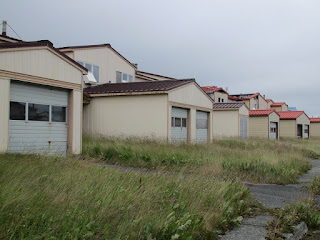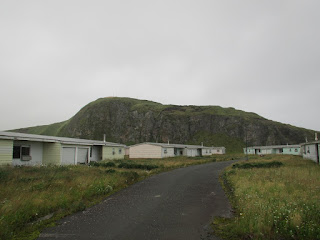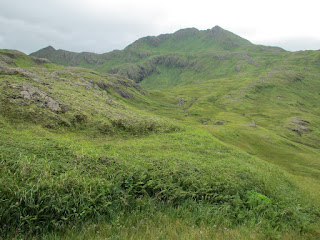
Three friends and I hopped on one of only two weekly flights to Adak Island to explore the old Cold War Navy base, and try and find some of the elusive caribou on the island. Adak Island was first inhabited by Aleut Natives prior to the arrival of Russian fur traders. After the sea otter numbers were depleted, the Russians moved further east in the Aleutian Island chain. It wasn't until WWII, well after the U.S. purchased Alaska from Russia, that Adak began to take a turn towards becoming a strategic outpost. After the Japanese captured the neighboring islands of Attu and Kiska, the U.S. Army set up a post on the island, followed shortly by the Naval Air Facility. The U.S. Navy stayed after the war, reaching a peak of 9,000 personnel on the small island during the Cold War, but in 1995 Naval Air Facility Adak was placed on the BRAC list and closed. Eventually, the Aleut Native Corporation obtained ownership of the remaining infrastructure, including all the hangars, airfield, port facilities, theater, exchange/commissary, school and the numerous base housing structures. Since then, vandalism and winds have wreaked havoc on the structures, as mother nature has begun to reclaim much of the former Navy base.
The Exploration

NAF Adak. Mitchell Field.

NAF Adak....the birthplace of the winds.

Inside the airport is a 3D map of the built-up portions of the island, showing the airfield, quarters, housing and other areas around the harbor.

The Native corporation offered some of the base housing units for sale, and now less than 100 permanent residents live in them, calling Adak home. The vast majority of the units, though, are vacant. At this unit, the family living there has hung out their salmon on drying racks.

We stayed in one of the units for our 4 day trip, owned and rented out by one of the locals.

Always good to review the identification characteristics of male/female caribou each time you reach for the fridge door.

Evidently the island has a rat problem....luckily, we saw none.

Much of base housing sits vacant, here pictured with one of the playground sets nearby, still in fairly good shape. Adak is both the Westernmost and Southernmost incorporated city in Alaska, and the temperatures it experiences are actually mild, preserving structures exposed to the elements (but the winds and vandalism have caused more damage than natural deterioration).

In a portion of the base protected from the worst winds, rows of empty base housing units look as though they are just waiting for families to return.

The airport scenery is quite spectacular.

Around the island, many rivetments mark locations where large guns, storage and other buildings were placed during the war, protected from enemy shelling inside their riveted positions.

An office building on the far north side of the facility.

The Marine barracks....'closed by order of the CO'.

The local Village Public Safety Officer. 'First Responder in the Last Frontier.'

The old "Flintstones" base housing units. These units are actually in the best shape even though they are the oldest, primarily because their short 1-story frame can withstand the constant wind a little better than the taller units. (Sometimes it's better to be shorter!)

Inside base housing, Navy furniture still sits where the last families left it, more than 20 years ago.

Adak gas station.

I think we're gonna to need a bigger boat.

Hidden ammo storage bunkers are spread throughout the island.



Many buildings are nearing collapse, making it difficult to tell their original purpose.

A WWII tank track lies abandoned near the top of Husky Pass, heading towards a remote harbor on the west side of the Island.

This dam provided fresh drinking water for the Naval Air Facility. It's still holding the water back, but is in need of some TLC.

A playground near the small boat harbor, with the adjoining building having already collapsed. Perhaps it was a daycare? Hard to tell.

Empty base housing units.

The only store on the island (The 100 Knot Store) only has 1 aisle, but that aisle is labeled "Aisle 5".

Adak had a McDonalds, 23 years ago.

The housing unit we stayed in had a nice framed Adak map for reference, with all the trails annotated, which helped us plan each day's hike/hunt routes.

Up on Bering Hill, the old church just barely stands.

Inside, the pews are ready for use, but the building around them is collapsing.

Easy to imagine the decades of worship that occurred here.

Chandeliers still hang in place.

View from the church building, through one of the holes created by the wind.

The bachelor enlisted quarters.


Inside, more furniture still sits, abandoned.

The hallways of the BEQ.

Two payphones displayed through the opening of a broken window.

You can't escape the eeriness of the empty structures.

Mold grows in some corners, and not in others, based mostly on which windows remain intact.

The BEQ lounge, with one solitary chair positioned looking out over Bering Hill.

The landscaping of 20 years ago can still be visualized.

The new chapel is the tsunami evacuation center, but even it was hit hard by vandalism.




Exchange/commissary.


Inside the school, empty lockers greet the occasional visitor.

A chemistry lab classroom.

The music room.

The gym of the Adak High School Eagles.

The gym floor has warped over time.

Paint, plaster and paper have peeled off the walls, but the school structure itself remains solid.

The cafeteria.


Post office. Wonder if mail could still be delivered to that address?

Moss and grass grows on the floors of the classrooms, even with desks and chalkboards still in usable condition.


Now this sight caught me a little by surprise. It was dark in the hallway, and I didn't have a flashlight. So I used the little canon zoom camera's flash to light up the room so I could see my way down the dark hall, and this is what I saw at the moment of flash. At first I thought these chairs were floating (and I began planning a quick exit!). But unfortunately this is another case of vandalism, with someone sticking these chairs in the drywall.

Nature begins reclaiming a classroom. You can almost picture the teacher and students sitting here 25 years ago.


That's not fire damage, that's from the winds. Some areas of base housing have really taken a beating from the strong Aleutian winds.

The "Flintstones" units, standing their ground behind a natural wind-block.

One of the old Navy hangars, with squadron patches still displayed.

U.S. Navy library book, sitting on a nightstand, marked "Discarded", matching the feeling around much of the island.

Property U.S. Navy, as it all was once.

We brought fresh fruit and vegetables with us, to pass out to the village. The best gift in a remote village like this is fresh produce, especially for the kids.

We did a little fishing while in Adak - and their salmon runs are not too shabby.


Adak - where the winds blow, and friendships grow.

An abandoned Navy duty truck, parked outside an empty base housing unit. Much of Adak gives you the feel of an evacuation, with many items inside and outside left right where they were.

The Fish and Wildlife office on the island maintains the WWII battleground plaques for the neighboring Attu and Kiska islands.
The Scenery

Flying in gave a great view of the long Aleutian chain of towering islands.

Adak itself is a beautiful island, and it was easy to walk along the tundra-like surface (no tussocks).

I can see why the school's mascot was the eagles. Eagles are everywhere on this island, even sitting on the viewing platform, which was built to allow us to stand on to better view the eagles!

This eagle was on the Navy mast outside the abandoned Marine barracks, and he took offense to my picture - - I must have not captured his good side.

The only thing more numerous than eagles on Adak, are sea otters, and they seem very comfortable holding that position.

A little further down the path, another eagle.

The views are quite magnificent, everywhere on the island.

Cotton grass. It used to be everywhere in Alaska, but has been mostly replaced by imported grasses. But in Adak, cotton grass still reigns.


The Hunt

For our hunt, we had a couple days to walk as much of the island as we could. We hit three of the four primary trails, and walked the full trail lengths. The island is about 20 miles by 20 miles, roughly, and we walked about 10 miles each day through quite a bit of elevation. There's no way we could cover the entire island in our time-frame, and with no sea-worthy boats remaining to take us to the south end of the island, our odds of finding the caribou herd weren't good. But we walked as much of the island as we could, hoping some of the herd might have returned north from their southern calving grounds. A good plan, considering caribou can migrate 1,000 miles when not constrained, so on this little island we hoped they would be moving.

But, they weren't, and none of the four groups who flew to the island with us saw any caribou that week. Lots of sign....tracks, bones from previous years' hunts, antler sheds....but no live caribou. But we saw plenty of other wildlife. In the picture above, a salmon is jumping in this small creek flowing into Finger Bay.
We also hunted ptarmigan, with success.

The chance to go to Adak, see the scenery and explore one of the most remote areas of the planet was a bucket list item, and I'm glad I got the chance to go.

Little Thumb Bay, both this pic and the one below.


Near Finger Bay.




An old cabin on the north end of the island.

Hiking towards Husky Pass.

Me and Mark Blair, my Chief of Plans.

Traversing Husky Pass.


Just over the pass, taking a break, and taking in the scenery. Over my right shoulder in the distance is the Pacific Ocean, and off camera to my left is the Bering Sea.


Mark and Rich Richards, from our Ops directorate, coming down from Husky Pass.


We didn't bring home any caribou meat, but I did grab a caribou antler shed for the boys, and enjoyed the once-in-a-lifetime chance to explore Adak Island.

oH mY I want to thank you oh so very much for taking out your precious time to both return to Adak as well as post all these pictures as well as giving brief descriptions and details! I was stationed on Adak 93 and 94 and I loved it! In the past I had many dreams to return! But with all these pics its like you allowed me to travel back into time! This IS so healing! And you gifted me many pictures! For this I say I love You! smile! Yes Really! You were Bold and Brave to go thru the town as and also take fresh veggies, wow. I got a kick out of you saying you were looking for an exit with the floating chairs! lol Well, once again I truly appreciate it! Take care of yourself and Best Health and WOnderful Adventures for your Future! chow Peace~ Lizah :)
ReplyDeletecanlı sex hattı
ReplyDeletehttps://girisadresi.info/
heets
salt likit
salt likit
FOAF8İ
https://saglamproxy.com
ReplyDeletemetin2 proxy
proxy satın al
knight online proxy
mobil proxy satın al
6ANİU